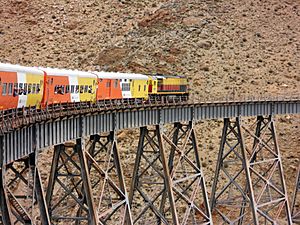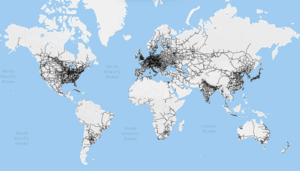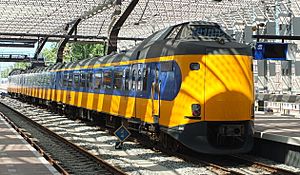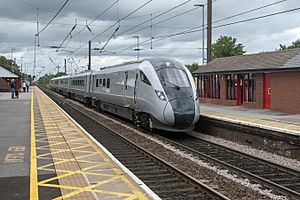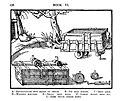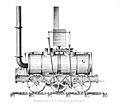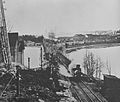Rail transport facts for kids
Rail transport is the movement of passengers and goods using wheeled vehicles, made to run on railway tracks. In most countries, this transportation method helps trade and economic growth. Railways provide an energy-efficient way to transport material over land.
Tracks usually consist of steel rails, installed on ties (sleepers) set in ballast, on which the rolling stock, usually fitted with metal wheels, moves. Other variations are also possible, such as slab track. This is where the rails are fastened to a concrete foundation resting on a prepared subsurface.
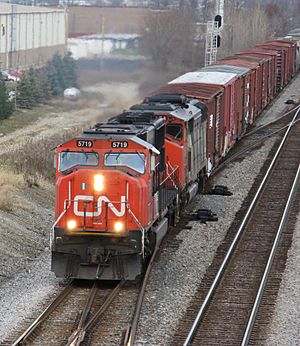
Rolling stock in a rail transport system generally encounters lower frictional resistance than rubber-tired road vehicles, so passenger and freight cars (carriages and wagons) can be coupled into longer trains. The operation is carried out by a railway company, providing transport between train stations or freight customer facilities. Power is provided by locomotives which either draw electric power from a railway electrification system or produce their own power, usually by diesel engines. Most tracks are accompanied by a signalling system. Railways are a safe land transport system when compared to other forms of transport. Railway transport is capable of high levels of passenger and cargo utilization and energy efficiency, but is often less flexible and more capital-intensive than road transport, when lower traffic levels are considered.
Rail transport started to be important in the Industrial Revolution.
The oldest known, man/animal-hauled railways date back to the 6th century BC in Corinth, Greece. Rail transport then commenced in mid 16th century in Germany in the form of horse-powered funiculars and wagonways. Modern rail transport commenced with the British development of the steam locomotives in the early 19th century. Thus the railway system in Great Britain is the oldest in the world. Built by George Stephenson and his son Robert's company Robert Stephenson and Company, the Locomotion No. 1 is the first steam locomotive to carry passengers on a public rail line, the Stockton and Darlington Railway in 1825. George Stephenson also built the first public inter-city railway line in the world to use only the steam locomotives all the time, the Liverpool and Manchester Railway which opened in 1830. With steam engines, one could construct mainline railways, which were a key component of the Industrial Revolution. Also, railways reduced the costs of shipping, and allowed for fewer lost goods, compared with water transport, which faced occasional sinking of ships. The change from canals to railways allowed for "national markets" in which prices varied very little from city to city. The spread of the railway network and the use of railway timetables, led to the standardisation of time (railway time) in Britain based on Greenwich Mean Time. Prior to this, major towns and cities varied their local time relative to GMT. The invention and development of the railway in the United Kingdom was one of the most important technological inventions of the 19th century. The world's first underground railway, the Metropolitan Railway (part of the London Underground), opened in 1863.
In the 1880s, electrified trains were introduced, leading to electrification of tramways and rapid transit systems. Starting during the 1940s, the non-electrified railways in most countries had their steam locomotives replaced by diesel-electric locomotives, with the process being almost complete by the 2000s. During the 1960s, electrified high-speed railway systems were introduced in Japan and later in some other countries. Many countries are in the process of replacing diesel locomotives with electric locomotives, mainly due to environmental concerns, a notable example being Switzerland, which has completely electrified its network. Other forms of guided ground transport outside the traditional railway definitions, such as monorail or maglev, have been tried but have seen limited use.
Following a decline after World War II due to competition from cars and airplanes, rail transport has had a revival in recent decades due to road congestion and rising fuel prices, as well as governments investing in rail as a means of reducing CO2 emissions in the context of concerns about global warming.
Related pages
Images for kids
-
KTT set operating the Guangdong Through Train service on the Guangshen railway, used by the MTR Corporation, an example of modern rail transport
-
A DR2800 series passing Sijiaoting railway station in Ruifang District, New Taipei, Taiwan
-
Minecart shown in De Re Metallica (1556). The guide pin fits in a groove between two wooden planks.
-
A replica of Trevithick's engine at the National Waterfront Museum, Swansea
-
Passengers waiting to board a tube train on the London Underground in the early 1900s (sketch by unknown artist)
-
Maschinenfabrik Oerlikon's first commercially AC-driven locomotive, the tramway in Lugano, Switzerland, 1896
-
0-Series Shinkansen, introduced in 1964, triggered the intercity train travel boom.
-
The VR Class Sm3 Pendolino high-speed train at the Central Railway Station of Tampere, Finland
-
SEPTA regional passenger train
-
Map of railways in Europe with main operational lines shown in black, heritage railway lines in green and former routes in light blue
-
Long freight train crossing the Stoney Creek viaduct on the Canadian Pacific Railway in southern British Columbia
-
Map of the world's railways showing the different gauges in use. Breaks of gauge generally occur where lines of different track gauge meet.
-
Bardon Hill box in England (seen here in 2009) is a Midland Railway box dating from 1899, although the original mechanical lever frame has been replaced by electrical switches.
-
Goods station in Lucerne, Switzerland
-
In the United States, railroads such as the Union Pacific traditionally own and operate both their rolling stock and infrastructure, with the company itself typically being privately owned.
-
BNSF Railway freight service in the United States
-
German Intercity Express (ICE)
See also
 In Spanish: Ferrocarril para niños
In Spanish: Ferrocarril para niños


